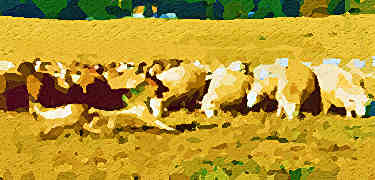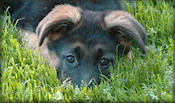The German Shepherd Dog
The most popular breed in the world, the German Shepherd Dog is recognized by just about everyone. Maybe they don't know the breed's official name and call it "Police Dog" or "Alsatian" -- but they recognize it as a dog known for it's ability to help people. This ability isn't an accidental happening. Through careful breeding from the shepherd dogs used for tending sheep in Germany for centuries, this breed developed quickly and was an almost instant hit with anyone needing a dog who could be an intelligent and courageous "working partner". A look at the historic uses and the characteristics and the working style of those dogs allows us to understand why the German Shepherd Dog of today looks and acts like he does.
Picture a flock of 700 to 1000 sheep grazing in an unfenced field. It's a pleasant sight -- quiet and relaxing. As the sheep graze along they spot the neighboring field and decide to head for greener pastures there. You are the shepherd responsible for this flock. You can't allow the sheep into the adjoining field and do damage to the crop as your herding insurance could be canceled and you'd be out of a job. But you aren't concerned. Patrolling the side of the field are your canine partners -- German Shepherd Dogs whose job it is to act as your fence.
You stand there watching your dogs move effortlessly up and down the sides of the field. They don't bother the sheep unless the sheep start to leave the designated grazing area. Then they are quick to react using enough force to quickly turn the sheep back across the boundary. They then resume their patrol. They do not wait for your command, but rather know what their responsibility is and carry it out.
It takes most of the day for your flock to finish grazing in the appropriate field. Your dogs have spent the entire day patrolling the boundary of the field and have everyone in their place. Now it's time to walk the flock back home and the dogs will act as a movable fence walking the sheep along the road, keeping them out of traffic, and delivering them safely to the barn yard. These dogs easily trotted 15-20 miles while doing their boundary work and they will do it again tomorrow and the next day.
It seems like a simple job -- any dog with endurance should be able to do it. But it is much more involved. These dogs must be intelligent enough to be able to quickly define a boundary even as it changes while the flock is moved. These dogs must be assertive enough to keep large and often determined sheep out of an area they really want to enter. They must be aggressive enough to be willing to discipline the sheep as needed and controlled enough to bite only wool and to stop biting when there's no more need. They must be protective enough to defend the human shepherd and the flock from harm. They must be willing to do much of this on their own without constant direction from the handler.
That's the heritage of the German Shepherd Dog. It required a dog that was unique. It required a dog who was very trainable, a willing worker, courageous, and physically sound. It required a dog who could work on his own making correct decisions without owner input. It also required a fluid, suspending gait that could be maintained for hours. These same traits will allow this breed to work endlessly searching for victims or evidence, work diligently as patrol partner for police or military, bring the crowd to their feet at a dog show, or patiently baby sit the kids. While not every German Shepherd Dog may excel at every activity, the basis should be there in every member of this breed, waiting for the right trainer and human partner to bring out the best in him.
For more information including the breed standard, please check out the artilces we have included. For more information we also invite you to visit the GERMAN SHEPHERD DOG CLUB OF AMERICA's website.

